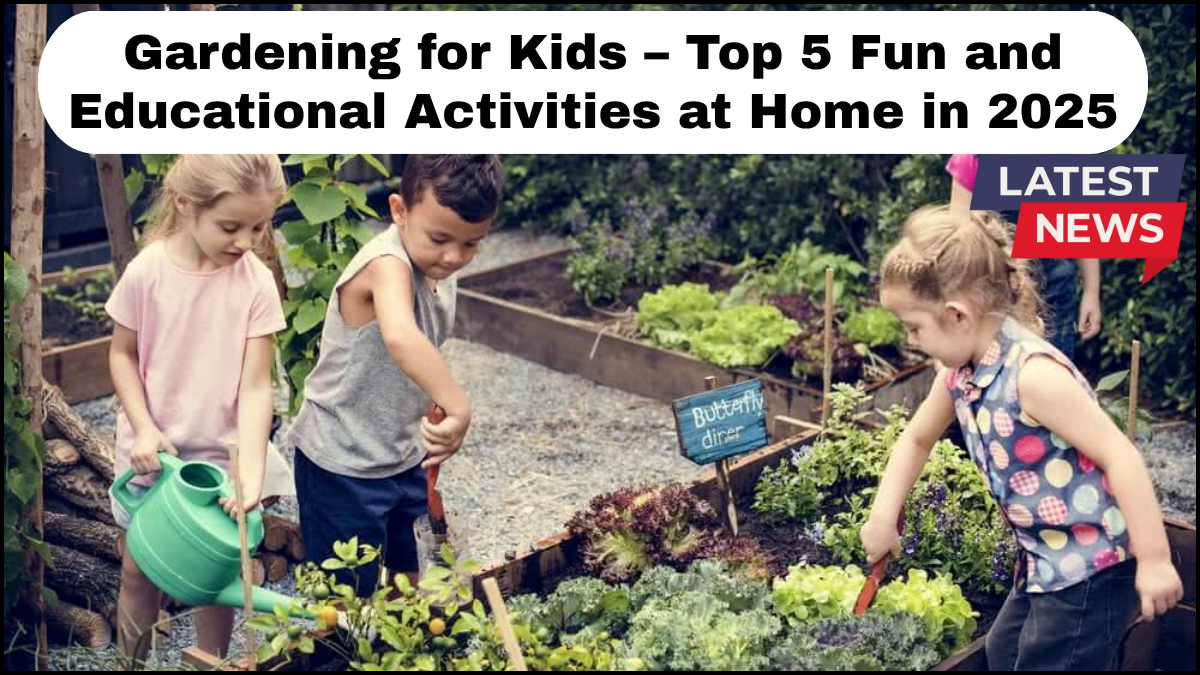Gardening for kids is more than just planting seeds—it’s a powerful tool for learning, creativity, and growth. In 2025, with more families focusing on at-home learning and hands-on experiences, educational gardening is emerging as a go-to activity to engage young minds. Whether you have a backyard, a balcony, or just a few containers by a window, there are plenty of fun, age-appropriate gardening activities that teach kids responsibility, patience, and the science behind nature.

Below are the top five gardening activities for kids that combine fun with valuable life lessons.
1. Grow Your Own Salad Garden
A salad garden is the perfect introduction to gardening for kids. It’s quick, interactive, and offers a direct reward: something they can eat.
What to plant: Lettuce, cherry tomatoes, radishes, baby carrots, and cucumbers.
Why it works: These crops grow relatively fast and are easy to manage. Kids get to witness the full cycle—from seed to table—within a few weeks.
Educational angle: This activity teaches children about plant biology, nutrition, and responsibility. You can introduce concepts like photosynthesis, the role of sunlight and water, and the importance of pollination in a way that’s easy to understand.
Bonus idea: Label each plant with DIY signs made from recycled materials. It enhances literacy and creativity.
2. Worm Composting Project
Turn food scraps into black gold while teaching kids about the importance of sustainability.
How to start: Get a small bin, red wiggler worms, and some kitchen scraps. Layer the bin with shredded newspaper, soil, and food waste.
Why it works: Kids love the idea of creepy crawlies with a purpose. Worm composting is low-maintenance and visually fascinating.
Educational benefits: This project reinforces eco-conscious habits, introduces decomposition and the food cycle, and explains soil health. It also demonstrates how living organisms contribute to healthy ecosystems.
Tip: Keep a “worm diary” to log what foods the worms like best and how quickly they decompose.
3. Build a Pollinator Paradise
Creating a pollinator garden helps children learn about the relationships between plants and animals.
What to include: Plant bee-friendly flowers like lavender, marigolds, and sunflowers. Add a shallow water dish with pebbles for bees and butterflies to rest.
Why it’s exciting: Watching butterflies flutter and bees buzz around gives kids a close-up look at the interconnectedness of life.
Educational Gardening insights: Kids learn about biodiversity, the role of pollinators in food production, and how to protect threatened species. It’s an early lesson in environmental stewardship.
Activity idea: Have kids track daily visitors to the garden with drawings or photos and identify species using free nature apps.
4. Sensory Herb Garden
Herb gardens engage all five senses—making them a perfect fit for younger children.
What to grow: Mint, basil, thyme, rosemary, and lemon balm.
Why it’s engaging: Herbs smell great, grow fast, and can be used in cooking or crafts. The tactile experience of touching fuzzy sage leaves or smelling fresh mint deepens sensory development.
Learning takeaways: Kids learn about plant identification, taste differences, and how herbs are used in different cultures. It’s also a gentle introduction to global cuisine and natural remedies.
Fun twist: Make a “scratch and sniff” herb chart using pressed herbs taped onto poster board.
5. Design a Themed Mini Garden
Let kids get creative by designing gardens based on their interests.
Ideas: Dinosaur garden with small ferns and toy dinos, fairy garden with moss and miniature furniture, or a rainbow vegetable garden organized by color.
Why it’s fun: Themed gardens combine storytelling with science, giving kids full creative control.
Educational value: This fosters design thinking, planning skills, and hands-on problem-solving. They’ll learn how to research plant types, measure space, and follow through on a project from concept to completion.
Suggestion: Use recycled containers or upcycled items like old boots or buckets to teach sustainability while adding a personal touch.
Why Gardening for Kids Matters in 2025
With screen time on the rise, there’s a growing need for real-world, tactile activities that encourage curiosity and responsibility. Gardening is the perfect antidote. It combines science, art, and physical activity in a safe, calming environment. More importantly, educational gardening fosters resilience, patience, and a sense of accomplishment—qualities that last far beyond childhood.
FAQs
1. What is the best age to introduce gardening to kids?
Children as young as two can start with simple tasks like watering or planting seeds. By age five, they can handle more involved projects like harvesting and composting.
2. Do I need a backyard for gardening with kids?
Not at all. Many activities can be done in containers, windowsills, or vertical gardens. Urban gardening is a great way to make use of small spaces.
3. How do I keep my child interested in gardening?
Let them choose what to plant, keep activities varied, and celebrate small successes like the first sprout or harvest. Gamifying progress or integrating crafts can also boost interest.
4. Is gardening safe for young children?
Yes, with supervision. Use kid-friendly tools, avoid toxic plants, and teach safe handling of soil and compost.
5. How does gardening help with education?
Gardening teaches biology, ecology, math (through measuring and planning), and responsibility. It also supports sensory development, emotional regulation, and critical thinking.
click here to learn more